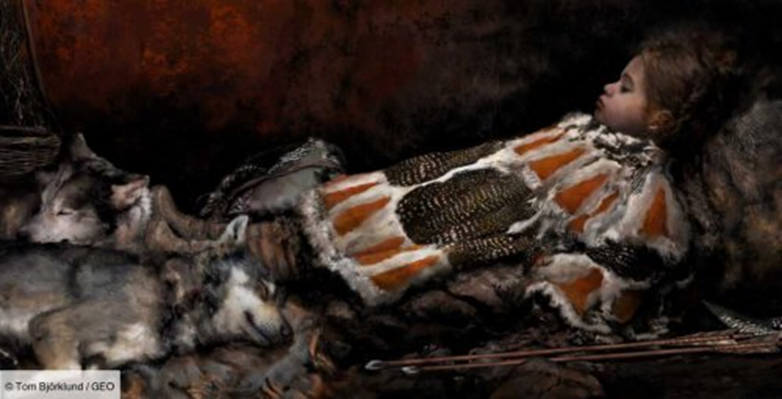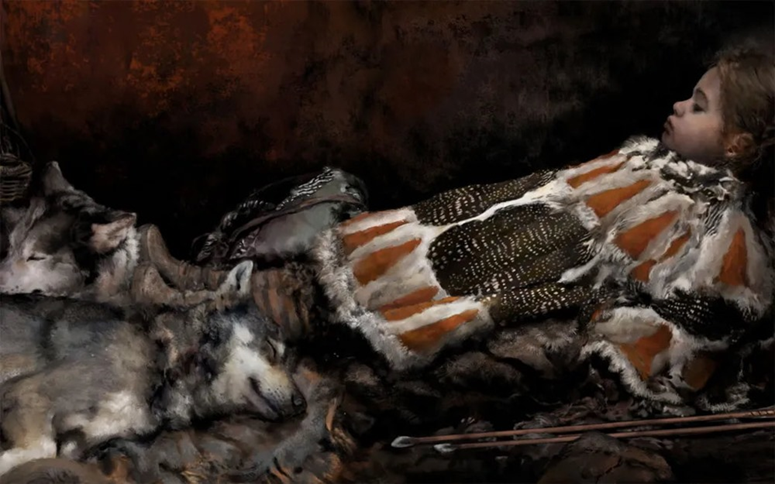In Finland, a 9,500-year-old tomb reveals a child buried with feathers and possibly a dog

In eastern Finland, archaeologists have studied a child's grave dating back to some 7,500 BCE. The young deceased, of whom only a few teeth remain, would have been buried with bird feathers and dog or wolf fur, or even with the animal itself.
Only a few fragments of the tomb remain but it seems to tell a fascinating story dating back 9,500 years. In Finland, archaeologists have conducted a new study on a Stone Age burial first unearthed in 1991 at the Majoonsuo site, located near the town of Outokumpu, in the southeast of the country. .
During the Stone Age in Finland, the deceased were buried mainly in pits dug in the ground. And this example is no exception. The grave appeared under a rocky sand road, in a forest. In 2018, researchers re-examined the site and found that its tip was partially exposed, raising fears that it could be destroyed.
They thus began new analyzes of the burial. Due to its location in the ground and the conditions prevailing there, few elements have resisted degradation and the ravages of time. But they were enough to reveal some clues about the identity of the deceased, the date of his death and the way in which he was buried.
A child aged 3 to 10

By analyzing the few teeth found - all that remains of the deceased - archaeologists determined that it was a child aged between three and ten years old. Two arrowheads made of quartz as well as a dating of the level suggested that the site dates back to the Mesolithic period, approximately 7,500 years before our era.
Unable to study possible human remains or additional artifacts, the team turned to the floor of the grave, which had the particularity of having been almost completely preserved. A total of 65 sample bags weighing between 0.6 and 34 kilograms were collected and supplemented with soil samples taken from outside the grave for comparison.
Microscopic examinations revealed that the young child had obviously not been buried alone. Around twenty microscopic fragments of feathers were identified in the samples, most of them coming from bird down. More precisely, seven of them could be associated with the plumage of Anseriformes, a group of aquatic birds including ducks and geese.
According to archaeologists, these are the oldest feather fragments ever discovered in Finland. However, it is difficult if not impossible to determine exactly in what form they got there. It is possible that the child was wearing clothing made from bird down such as a coat or parka. But it is also possible that he was placed on a feather bed.
In addition to these fragments, one sample in particular was identified as coming from a specimen of the Falconidae family, including falcons. Here again, doubt remains as to its origin. It could come from the fletching of the arrows whose heads were found but these feathers could also have served as decoration for the burial.

?Buried with a dog
The presence of these elements in the pit is not a surprise to archaeologists. Various graves exhumed in neighboring Finnish regions have shown that the deceased were often accompanied by objects made from bones, teeth, horns, as well as feathers and furs, during their final journey.
The tomb lies under a rocky sand road at the Majoonsuo site in Finland.
In addition to bird attributes, the analysis of soil samples also revealed fragments of mammal hairs, 0.5 to 9.5 millimeters long. Most being very damaged, no identification could be made. Three hairs found at the bottom of the tomb could, however, be attributed to a canine. A dog ? A wolf ? We ignore it.
Like feathers, hair could come from clothing or rather shoes made from wolf or dog skin. But the archaeologists, who published their research in the journal PLoS One last September, do not exclude the possibility that the child was buried with a real animal - dog or wolf - at his feet.
“Dogs buried with deceased people have been found, for example at Skateholm, a famous burial site located in southern Sweden and dating back some 7,000 years,” underlined Professor Kristiina Mannermaa, specialist from the University of Helsinki in leading a project that studies social connections between humans and animals at Stone Age burial sites.

Mesolithic Child Finland 3 22According to Kristiina Mannermaa, researcher and associate professor at the Department of Cultures at the University of Helsinki:
"The discovery at Majoonsuo is sensational, even though there is nothing left of the animal(s) other than hair - not even teeth. We don't even know if it's a dog or a wolf," he said. -she explained in a press release. “The method used demonstrates that traces of fur and feathers can be found in millennia-old graves, including in Finland.”
Shedding light on the funerary practices of the time
Some hairs from small mammals could be identified. They could nevertheless have landed there secondarily and not have been intentionally placed in the burial which also contained other elements. To complete the inventory, three fragments of plant fibers appeared in the samples.
Potentially made from wicker or brambles, they could testify to the presence of various objects such as a fishing net, a cord for tying clothes or a set of ropes. Until now, only one example of this type dating from the Mesolithic was known in Finland: the Antrea fishing net found in 1913 and considered one of the oldest in the world.
Down coat or feather bed? Skin shoes or real dog? Many questions remain about the burial of this mysterious Mesolithic child. But the discoveries made by the researchers provide important information on the practices, particularly funerary practices, of this period of the Stone Age.
“The work is really slow and it really made my heart skip a beat when I found the tiny fragments of clothing and furniture from the grave, especially in Finland where any unburned bones tend to decompose,” Kristiina Mannermaa told CNN. “All of this gives us very valuable insight into Stone Age burial habits, indicating how this child was prepared for its journey after death.”
Source: websites

